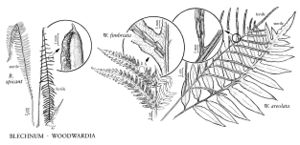Blechnaceae
Plants perennial, mostly terrestrial, occasionally on rock or epiphytic. Stems creeping to suberect or ascending, sometimes climbing [rarely arborescent], slender to stout, dictyostelic, scaly. Leaves monomorphic or dimorphic, large and coarse, generally greater than 30 cm, often exceeding 1 m. Petiole not articulate, generally more than 2 vascular bundles arranged in arc, generally scaly at least at base. Blade often anthocyanic (reddish) when young, pinnatifid [rarely simple] to pinnate-pinnatifid or 2-pinnate [rarely decompound], glabrous or occasionally bearing scales or capitate glands. Rachis frequently grooved adaxially. Veins of sterile leaves generally free, rarely anastomosing, veins of fertile leaves united to form sorus-bearing secondary vein parallel to costa or costule (vascular commisure), sometimes anastomosing further. Sori elongate along secondary vein; indusia present [rarely absent], opening along costal side of fertile vein, frequently hidden by dehisced sporangia; sporangial stalk of 3 rows of cells. Spores monolete, reniform; perine present, variously ornamented. Gametophytes green, cordate, sometimes bearing capitate hairs, antheridia and archegonia borne on lower surface.
Distribution
Mostly tropical and south temperate (except Woodwardia, which is north temperate).
Discussion
Circumscription of genera is controversial, especially as to placement of those species now included in Blechnum. Characteristics holding the family together include the anastomoses of veins along the axes of the blade to form a series of areoles or a single continuous vein along which the sorus is borne, elongate sori with indusia opening toward midvein, bilateral spores, and chromosome base numbers of generally x = 28–36. Relationships of the family with both dryopteroid and athyrioid ferns have been suggested.
Stenochlaena tenuifolia (Desvaux) T. Moore, native to the Old World, was reported as escaped from cultivation in the 1930s in southern Florida; it has not been collected there recently. It is distinguished by having climbing stems and by having contracted, 2-pinnate fertile leaves with sporangia covering the abaxial surface.
Genera ca. 10, species ca. 250 (2 genera, 6 species in the flora).
Selected References
None.
Lower Taxa
Illustrations
| Family ⠉ | Taxon | Illustrator ⠉ | |
|---|---|---|---|
 | Blechnaceae Blechnaceae Blechnaceae | Blechnum spicant Woodwardia fimbriata Woodwardia areolata | John Myers John Myers John Myers |
Key
| 1 | Sori continuous along length of costa or costule; veins of sterile leaves free. | Blechnum |
| 1 | Sori distinct, in chainlike rows along costa or costule; veins of sterile leaves anastomosing at least along costae and costules. | Woodwardia |